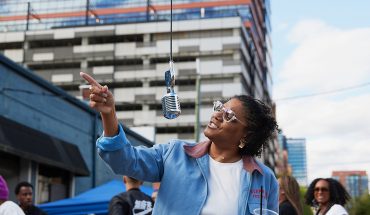
photos courtesy WakeMed
by Jessie Ammons
Tucked behind WakeMed hospital at the end of an unassuming side street stands a stately stone house, a gracious counterpoint to the health care center’s sprawling clinical grounds.
“It’s always had a great spirit,” says Diane Smith, whose grandparents-in-law – Dr. Clarence Poe and his wife, Alice Aycock Poe – built the house in 1925. After decades of serving as a family home and then as a community event venue, Poe’s descendants donated the property to WakeMed in 2011. Recently, it was restored to serve as a hospital meeting space and as offices for the WakeMed Foundation. “It’s humming,” says Abby Johnston, director of major and planned gifts at the foundation. “We have a home now.”

photos courtesy WakeMed. Most of the light fixtures and chandeliers throughout the house are original. The antique furniture in the foyer is from Acquisitions, Ltd. and donated by the Smith family, who are descendants of Dr. Poe (and owned the house and operated it as an event venue for a time in the ’90s). Many of the rugs were donated by WakeMed Foundation staff.

photos courtesy WakeMed
It’s a handsome one, a place with easy elegance. Sand-colored stone and black shutters outside give way to a grand foyer featuring a sweeping staircase. Original chandeliers and light fixtures hang throughout, adding a bit of sparkle to rooms with simple, mostly bare walls in subdued colors and restored hardwood floors. There’s a sunporch on the ground floor and a former sleeping porch – now enclosed with windows – stacked above it. Built-in bookshelves accentuate high ceilings in the downstairs study, which is now a walk-through office. Most every room includes a fireplace, and upstairs two of the bathrooms still have claw-footed bathtubs.

photo courtesy of WakeMed. Furniture, even in the large living room (pictured on adjacent page), is purposefully spare so that it can easily be moved aside to make room for functional tables and chairs on wheels donated by Alfred Williams and Company: Hospital staff and the WakeMed Foundation board use the rooms for conferences, training, and receptions. “This house is built well,” says Tom Calvander, WakeMed’s vice president of facilities and construction, who led the restoration. “It has a good air to it.”
Smith says the decision to donate the house was in line with the original owner’s legacy. Clarence Poe, a civic leader and early Raleigh visionary, was a Chatham County native who became associate editor of The Progressive Farmer at 16 and went on to become its editor. He worked in downtown Raleigh for 67 years. When he purchased the plot of land for his house in 1919, it was just far enough from town – a straight three miles – to allow for a pleasant commute: “He rode his horse to his office downtown, and he wanted a good ride in the morning,” Smith says.
Gradually, Poe amassed nearly 800 acres, where he put into practice the principles of his newspaper: He made his house out of stone quarried on the property, and built a working farm and dairy. The Poes dubbed their estate “Longview” to honor both the scene from the front porch and their intent to stimulate growth and development in the area. Today, that tract encompasses the WakeMed campus and the Longview Gardens Historic District (a residential neighborhood Poe helped create), as well as the grounds of the Raleigh Country Club.

Dr. Clarence Poe’s daily commute in the ’20s was a three-mile trek on horseback to downtown Raleigh. courtesy Diane Smith
The Poe House sits on a remaining 14 acres of land. “It’s always been a home and it’s always been a happy place,” Smith says. “For years, whenever there was a family occasion, it was always there.” Tradition came full-circle last May when Smith’s daughter, Clarence Poe’s great-granddaughter Catherine Smith Farley, held her wedding reception at the home before the WakeMed foundation moved in in September. “Her grandmother was married there. Seventy-five years later, the house was still a happy wonderful place for a family event.”
Its current incarnation as home to the hospital’s foundation is “giving the house a rebirth,” Smith says. “It’s bringing it back to life.”
Inheriting a home as office space has sentimental gravitas that’s not lost on the hospital staff. “This is an institutional treasure and we knew it needed to be treated differently than other hospital structures,” says the foundation’s executive director, Brad Davis. “When it gets to a home, it feels a bit more personal.”
Attention to detail infused every step of the renovation process. “We matched paint colors to old photos (of the house),” says Tom Calvander, WakeMed’s vice president of facilities and construction (who admits with a chuckle that his day-to-day doesn’t usually involve finding someone to carefully clean antique chandeliers). “We worked really hard to maintain the integrity of the original home.”

Dr. Poe’s great-granddaughter Catherine Smith Farley’s wedding reception was held at the ancestral home last May. Vesic Photography

Vesic Photography
That integrity remains in today’s workspace thanks also to sleek Alfred Williams and Company furniture-on-wheels, a donation from hospital supporter and longtime Foundation board member Blount Williams. Tables and chairs fold up and easily move among the restored original rooms. Many foundation staff members donated rugs and other elements, and the Smith family donated antique furniture to outfit the foyer. The sleeping porch is now a conference room, available for any WakeMed doctors, nurses, and other staff members to rent out and use, and upstairs bedrooms are foundation offices. “We have pretty good team morale, anyway,” Johnston says, “but since moving in, there’s been a noticeable shift. There’s a good vibe here. We take pride in this place.”
Smith says that’s everything Dr. Poe would have wanted: for the house to be accommodating and bustling, a place to turn principles into practice. “It’s a wonderful face for the WakeMed Foundation. They’re going to use it, they’re going to love it, and I think it’s what it should be again.”
Executive director Davis agrees: “Setting is important for framing who an institution is and what it does. This is a unique setting outside of either a corporate or a clinical setting. You feel miles away. Hospitals are a great place to show impact, but as far as broader conversations – training, planning, celebrating, building camaraderie – this is a special place for WakeMed’s mission to really blossom.”



